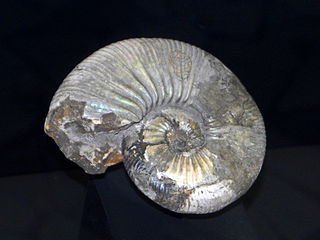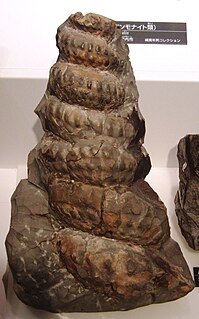 W
WAmmonitida is an order of more highly evolved ammonoid cephalopods that lived from the Jurassic through Cretaceous time periods, commonly with intricate ammonitic sutures.
 W
WAcanthohoplites is an extinct genus of ammonites in the family Parahoplitidae that lived in the Aptian and Early Albian stages of the Early Cretaceous.
 W
WArnioceras is an extinct genus of large, evolute, discoidal ammonite from the Lower Jurassic. The shell is normally coiled so that all whorls are exposed. Sides bear strong sharp ribs that are straight until reaching the ventrolateral edge where they swing forward and fade. The rim (venter) is keeled and free of grooves.
 W
WBeloceras is a genus of ammonites included in the family Beloceratidae. These fast-moving nektonic carnivores lived in the Late Devonian period, from 379.5 to 376.1 Ma.
 W
WCleoniceras is a rather involute, high-whorled hoplitid from the Lower to basal Middle Albian of Europe, Madagascar, and Transcaspian region. The shell has a generally small umbilicus, arched to acute venter, and typically at some growth stage, falcoid ribs that spring in pairs from umbilical tubercles, usually disappearing on the outer whorls.
 W
WJuraphyllites is a genus of ammonites belonging to the family Juraphyllitidae.
 W
WMantelliceras is an extinct ammonoid cephalopod genus belonging to the family Acanthoceratidae and type for the Mantelliceratinae, that lived from the Late Albian to the late Cenomanian stage of the Late Cretaceous.
 W
WManticoceras is a genus of ammonites included in the family Gephuroceratidae. These fast-moving nektonic carnivores lived in the Devonian period, from 382.4 to 376.1 Ma.
 W
WMariella is an ammonoid genus, named by Nowak (1916) from the upper Albian and Cenomanian stages of the mid Cretaceous, included in the Turrilitidae. Its type is Turrilites bergeri
 W
WTurrilites (Turrilites) costatus is a species of helically coiled ammonoid cephalopod, from the lower part of the Upper Cretaceous (Cenomanian).